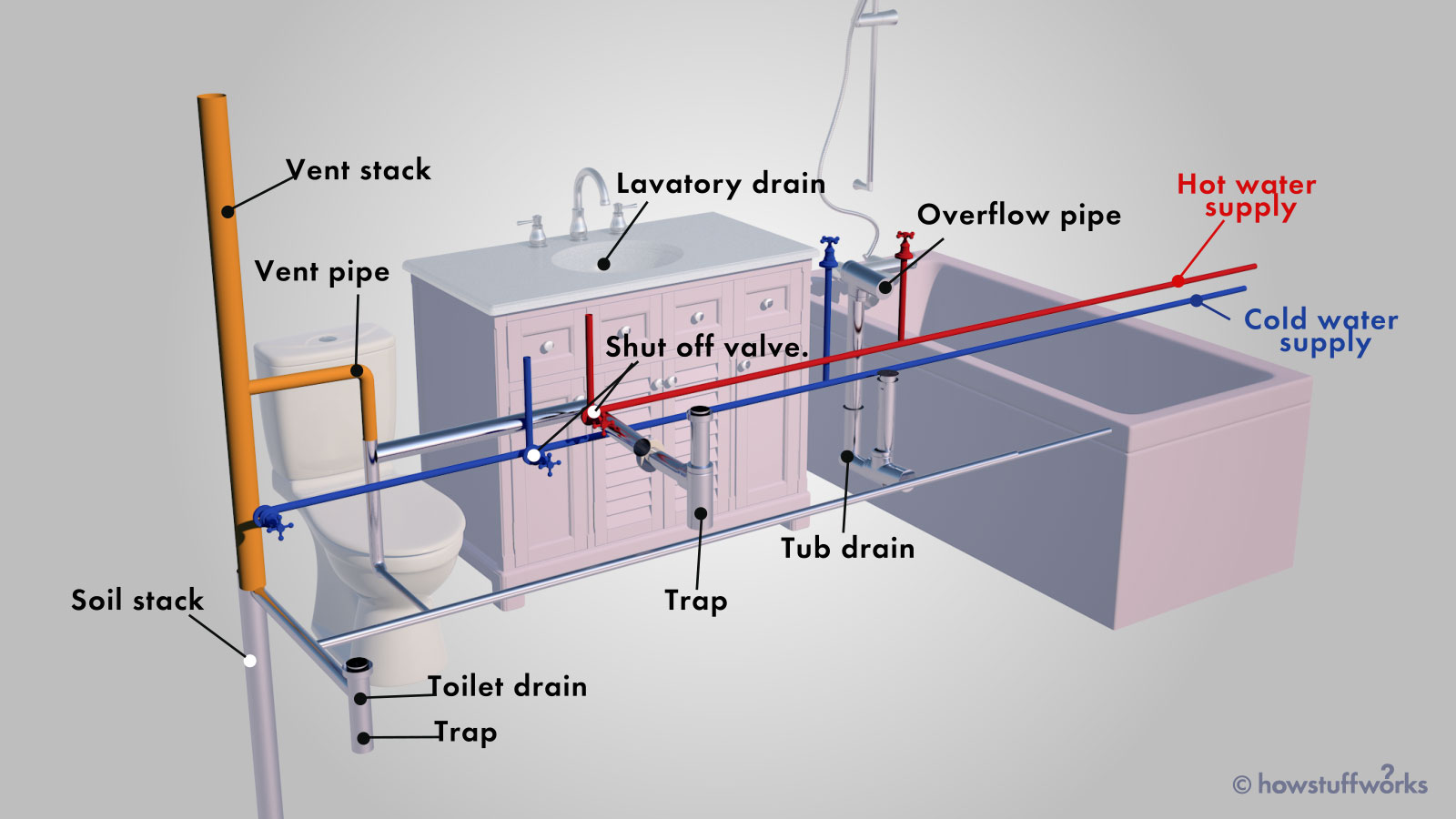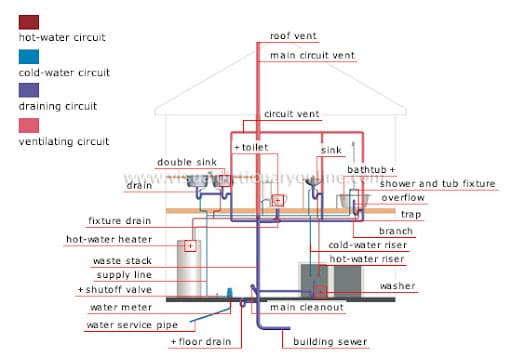The Complete Look at Your Home's Plumbing System Anatomy
The Complete Look at Your Home's Plumbing System Anatomy
Blog Article
We've noticed this article on Plumbing Installation 101: All You Need to Know down the page on the internet and felt it made perfect sense to write about it with you on this page.

Understanding exactly how your home's pipes system works is necessary for every homeowner. From providing clean water for drinking, cooking, and bathing to securely getting rid of wastewater, a properly maintained plumbing system is important for your family members's health and comfort. In this detailed overview, we'll explore the elaborate network that comprises your home's pipes and deal tips on maintenance, upgrades, and managing common issues.
Introduction
Your home's plumbing system is more than simply a network of pipelines; it's an intricate system that guarantees you have access to clean water and effective wastewater removal. Understanding its parts and just how they interact can help you prevent pricey repairs and ensure everything runs efficiently.
Standard Elements of a Plumbing System
Pipes and Tubing
At the heart of your plumbing system are the pipelines and tubes that bring water throughout your home. These can be made from different materials such as copper, PVC, or PEX, each with its advantages in regards to durability and cost-effectiveness.
Components: Sinks, Toilets, Showers, and so on.
Components like sinks, bathrooms, showers, and bathtubs are where water is used in your house. Recognizing exactly how these fixtures connect to the plumbing system assists in identifying issues and preparing upgrades.
Shutoffs and Shut-off Points
Valves control the circulation of water in your pipes system. Shut-off shutoffs are crucial during emergencies or when you require to make fixings, permitting you to separate parts of the system without interfering with water flow to the entire house.
Water System
Key Water Line
The primary water line attaches your home to the local supply of water or a private well. It's where water enters your home and is distributed to numerous fixtures.
Water Meter and Pressure Regulatory Authority
The water meter actions your water usage, while a pressure regulator guarantees that water flows at a safe stress throughout your home's pipes system, protecting against damage to pipes and components.
Cold Water vs. Warm water Lines
Comprehending the difference in between cold water lines, which provide water directly from the primary, and hot water lines, which lug heated water from the water heater, helps in repairing and preparing for upgrades.
Drainage System
Drain Pipes Water Lines and Traps
Drain pipes lug wastewater far from sinks, showers, and toilets to the sewer or septic system. Traps prevent sewage system gases from entering your home and likewise catch particles that might cause obstructions.
Ventilation Pipelines
Ventilation pipelines permit air into the water drainage system, stopping suction that can slow down drainage and trigger traps to vacant. Appropriate air flow is necessary for maintaining the honesty of your plumbing system.
Value of Proper Water Drainage
Guaranteeing correct drainage stops back-ups and water damage. Consistently cleaning up drains pipes and maintaining catches can protect against expensive fixings and extend the life of your plumbing system.
Water Heating System
Kinds Of Hot Water Heater
Hot water heater can be tankless or conventional tank-style. Tankless heating units warmth water on demand, while containers store heated water for instant usage.
Updating Your Plumbing System
Reasons for Upgrading
Updating to water-efficient fixtures or replacing old pipes can boost water top quality, decrease water expenses, and boost the value of your home.
Modern Plumbing Technologies and Their Benefits
Check out modern technologies like clever leak detectors, water-saving toilets, and energy-efficient hot water heater that can conserve cash and reduce environmental effect.
Expense Factors To Consider and ROI
Compute the upfront expenses versus long-lasting cost savings when taking into consideration pipes upgrades. Several upgrades spend for themselves through decreased energy bills and fewer repair work.
Exactly How Water Heaters Link to the Pipes System
Comprehending exactly how hot water heater link to both the cold water supply and warm water circulation lines assists in identifying problems like not enough hot water or leaks.
Maintenance Tips for Water Heaters
Frequently flushing your hot water heater to get rid of sediment, checking the temperature setups, and inspecting for leakages can expand its life-span and enhance power performance.
Usual Pipes Problems
Leaks and Their Causes
Leakages can take place as a result of maturing pipelines, loose fittings, or high water stress. Resolving leakages immediately protects against water damages and mold growth.
Obstructions and Clogs
Blockages in drains and bathrooms are frequently caused by purging non-flushable products or a buildup of oil and hair. Making use of drain screens and bearing in mind what decreases your drains can protect against blockages.
Signs of Pipes Troubles to Watch For
Low tide stress, slow drains pipes, foul odors, or uncommonly high water bills are indicators of potential pipes issues that should be resolved immediately.
Plumbing Upkeep Tips
Routine Evaluations and Checks
Schedule yearly plumbing examinations to catch concerns early. Try to find signs of leakages, rust, or mineral build-up in faucets and showerheads.
Do It Yourself Maintenance Tasks
Simple jobs like cleaning tap aerators, checking for commode leaks making use of dye tablet computers, or insulating revealed pipes in cool climates can protect against major pipes issues.
When to Call a Specialist Plumbing Technician
Know when a plumbing problem requires expert proficiency. Trying complex repair services without proper expertise can result in even more damages and greater repair service expenses.
Tips for Decreasing Water Use
Simple routines like fixing leaks immediately, taking much shorter showers, and running full lots of laundry and meals can save water and reduced your utility expenses.
Eco-Friendly Pipes Options
Take into consideration sustainable pipes products like bamboo for floor covering, which is durable and environment-friendly, or recycled glass for kitchen counters.
Emergency Preparedness
Steps to Take Throughout a Pipes Emergency
Know where your shut-off valves are located and exactly how to switch off the water supply in case of a burst pipeline or significant leakage.
Importance of Having Emergency Get In Touches With Helpful
Maintain call information for regional plumbing professionals or emergency situation solutions readily available for quick response throughout a pipes situation.
Ecological Influence and Preservation
Water-Saving Components and Devices
Mounting low-flow faucets, showerheads, and toilets can considerably decrease water usage without compromising performance.
Do It Yourself Emergency Situation Fixes (When Suitable).
Short-term fixes like making use of air duct tape to spot a dripping pipeline or positioning a pail under a trickling tap can lessen damage up until a professional plumbing technician shows up.
Final thought.
Comprehending the anatomy of your home's plumbing system encourages you to keep it properly, conserving money and time on repair services. By complying with routine maintenance regimens and remaining notified regarding contemporary plumbing modern technologies, you can guarantee your plumbing system operates successfully for several years ahead.
HOW YOUR PLUMBING SYSTEM WORKS
Which Pipes Do What?
Blue lines = fresh water supply entering the building Red lines = hot water supply entering the building Grey lines = pipes carrying waste away from the building and venting pipes carrying gases away from the building (through the roof) YOUR MAIN PLUMBING SYSTEMS
There are two main plumbing systems that support your home s basic plumbing needs one that brings clean water into your home, and one that sends dirty water away from your home. Connected to the toilet, bath, shower, and other faucets in your home, these two systems keep your water flowing in the right directions.
ACCESSING FRESH WATER
Fresh and clean water is brought into your home through the main water supply line . Filtered through one pipe, this water is pressured to flow into the various fixtures in your home at any given time.
This water can be sourced from a well located on your property, a pond or river (mostly cottages), or, as in most cases, from the city s municipal water treatment centre. However, it is important to note that water that is untreated, such as the water siphoned from ponds or rivers, may not be safe to drink. Personal water supplies always need to be treated for hardness and contaminants before consumed.
MUNICIPAL WATER SUPPLIES
Improve taste and odour Remove sediment Eliminate hardness Reduce chlorine COLD WATER SUPPLY VS. HOT WATER SUPPLY
Cold water flows into your home or building through the service line, which then distributes hot or cold water to your fixtures. This line is most commonly run through a central column that runs floor to floor. Hot water runs in short and straight pipes as the longer the pipeline, the more heat that will be lost in the transfer. Having shorter pipes also allows residents to access hot water more quickly.
WASTE WATER SYSTEM
Your wastewater system is divided into two parts pipes that send wastewater away from your home and venting pipes that send sewer gas away from your home. Sewage water travels through pipes that flush the water and waste towards local sewers that are operated and managed by your city or town. Most sewer systems rely on gravity to move the wastewater to where it needs to go.
The further away from your toilet or sink, the larger wastewater pipes become. This allows for waste to be disposed of from various parts of your home or business at once without pipe blockages. The angle and flow of these pipes are also essential for keeping your waste pipes clear of build up.
https://harrisplumbing.ca/how-your-home-plumbing-system-works/

We were made aware of that write-up about Plumbing Installation 101: All You Need to Know from someone on a different website. Do you know about somebody who is in the market for the topic? Please feel free to share it. Thanks a bunch for being here. Please visit our blog back soon.
Go Company Report this page